-
 Afrikaans
Afrikaans -
 Albanian
Albanian -
 Amharic
Amharic -
 Arabic
Arabic -
 Armenian
Armenian -
 Azerbaijani
Azerbaijani -
 Basque
Basque -
 Belarusian
Belarusian -
 Bengali
Bengali -
 Bosnian
Bosnian -
 Bulgarian
Bulgarian -
 Catalan
Catalan -
 Cebuano
Cebuano -
 China
China -
 Corsican
Corsican -
 Croatian
Croatian -
 Czech
Czech -
 Danish
Danish -
 Dutch
Dutch -
 English
English -
 Esperanto
Esperanto -
 Estonian
Estonian -
 Finnish
Finnish -
 French
French -
 Frisian
Frisian -
 Galician
Galician -
 Georgian
Georgian -
 German
German -
 Greek
Greek -
 Gujarati
Gujarati -
 Haitian Creole
Haitian Creole -
 hausa
hausa -
 hawaiian
hawaiian -
 Hebrew
Hebrew -
 Hindi
Hindi -
 Miao
Miao -
 Hungarian
Hungarian -
 Icelandic
Icelandic -
 igbo
igbo -
 Indonesian
Indonesian -
 irish
irish -
 Italian
Italian -
 Japanese
Japanese -
 Javanese
Javanese -
 Kannada
Kannada -
 kazakh
kazakh -
 Khmer
Khmer -
 Rwandese
Rwandese -
 Korean
Korean -
 Kurdish
Kurdish -
 Kyrgyz
Kyrgyz -
 Lao
Lao -
 Latin
Latin -
 Latvian
Latvian -
 Lithuanian
Lithuanian -
 Luxembourgish
Luxembourgish -
 Macedonian
Macedonian -
 Malgashi
Malgashi -
 Malay
Malay -
 Malayalam
Malayalam -
 Maltese
Maltese -
 Maori
Maori -
 Marathi
Marathi -
 Mongolian
Mongolian -
 Myanmar
Myanmar -
 Nepali
Nepali -
 Norwegian
Norwegian -
 Norwegian
Norwegian -
 Occitan
Occitan -
 Pashto
Pashto -
 Persian
Persian -
 Polish
Polish -
 Portuguese
Portuguese -
 Punjabi
Punjabi -
 Romanian
Romanian -
 Russian
Russian -
 Samoan
Samoan -
 Scottish Gaelic
Scottish Gaelic -
 Serbian
Serbian -
 Sesotho
Sesotho -
 Shona
Shona -
 Sindhi
Sindhi -
 Sinhala
Sinhala -
 Slovak
Slovak -
 Slovenian
Slovenian -
 Somali
Somali -
 Spanish
Spanish -
 Sundanese
Sundanese -
 Swahili
Swahili -
 Swedish
Swedish -
 Tagalog
Tagalog -
 Tajik
Tajik -
 Tamil
Tamil -
 Tatar
Tatar -
 Telugu
Telugu -
 Thai
Thai -
 Turkish
Turkish -
 Turkmen
Turkmen -
 Ukrainian
Ukrainian -
 Urdu
Urdu -
 Uighur
Uighur -
 Uzbek
Uzbek -
 Vietnamese
Vietnamese -
 Welsh
Welsh -
 Bantu
Bantu -
 Yiddish
Yiddish -
 Yoruba
Yoruba -
 Zulu
Zulu
hail nets
The Importance of Hail Nets in Agriculture
Hailstorms are a severe weather phenomenon that can devastate agricultural crops, causing significant economic losses for farmers. These unpredictable events can lead to damage ranging from minor bruising to complete destruction of fruit and vegetable harvests. As a response to this growing concern, the use of hail nets has become increasingly prevalent in agricultural practices. Hail nets, also known as hail protection nets, are a practical solution designed to shield crops from hail damage while also providing other benefits.
One of the primary advantages of using hail nets is their ability to protect crops from the harmful impact of hailstones. A hail net is typically made of durable, flexible materials such as polyethylene, allowing it to withstand the force of hail while flexibly absorbing the impact. When installed over or around crops, these nets can significantly reduce the amount of damage caused by hail, thus preserving the quality and quantity of the harvest. This protection is particularly vital for high-value crops such as grapes, cherries, and other fruits that directly contribute to a farm's income.
In addition to providing physical protection from hail, these nets also offer other agricultural benefits
. For instance, hail nets can provide shade to crops, which can be particularly helpful in regions experiencing high temperatures. This shade helps regulate the temperature of the plants and reduces water evaporation, leading to better growth conditions and potentially higher yields. Moreover, the nets can help protect crops from excessive sun exposure, thus preventing sunburn and ensuring that the fruits maintain their quality.hail nets

Hail nets also play a role in pest management. By creating a physical barrier, they can help deter certain pests and birds that might otherwise cause damage to the crops. This protective feature can reduce the need for chemical pest control measures, ultimately contributing to more sustainable farming practices. Additionally, the nets can help reduce the incidence of debris and dust settling on the crops, leading to cleaner and healthier produce.
Installing hail nets, however, comes with its own set of challenges. Initial costs for high-quality nets and their installation can be a significant investment for farmers. It requires careful planning to ensure proper coverage and installation methods that will withstand strong winds and heavy precipitation. Yet, the long-term benefits often outweigh these initial expenditures. Farmers who invest in hail nets typically find that the protection they offer leads to increased marketable yields, ultimately improving their financial returns.
Furthermore, as climate change continues to influence weather patterns, the occurrence and severity of hailstorms may increase, making hail protection systems essential. Farmers must adapt to these changing conditions to secure their livelihoods, and hail nets present a viable option in this regard.
In conclusion, hail nets are an essential tool for modern agriculture in regions prone to hailstorms. They provide much-needed protection against hail damage while also offering additional benefits like temperature regulation, pest management, and improved crop quality. As weather patterns shift and farmers face new challenges, investing in hail nets can be a strategic move to safeguard crops and ensure agricultural sustainability for future generations. As the agricultural landscape evolves, the implementation of crop protection solutions, such as hail nets, will be critical in helping farmers thrive in an unpredictable environment.
-
Shipping Plastic Bags for Every NeedNewsJul.24,2025
-
Safety Netting: Your Shield in ConstructionNewsJul.24,2025
-
Plastic Mesh Netting for Everyday UseNewsJul.24,2025
-
Nylon Netting for Every UseNewsJul.24,2025
-
Mesh Breeder Box for Fish TanksNewsJul.24,2025
-
Expanded Steel Mesh Offers Durable VersatilityNewsJul.24,2025











